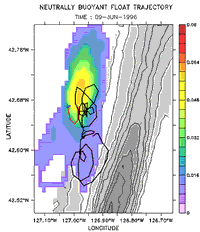|
An early response cruise to the site of the Gorda Ridge eruption in 1996 found a large event plume in March, and a second cruise found a different event plume in April. This second event plume became the first to be seeded and tracked with a neutrally buoyant RAFOS drifter float. The RAFOS drifter tracked the eddy-like rotation of event plumes and allowed us, for the first time, to resample the same plume 2 months later. Little chemical change was found between sampling periods, suggesting that event plumes have a long residence time as discrete entities in the deep ocean. The Gorda Ridge event was unusual in another way, in that venting was extinguished within 3 months of the eruption, much faster than at either Cleft or CoAxial. Click the image to view an animation of the float track from April to June, 1996. Reference: |

